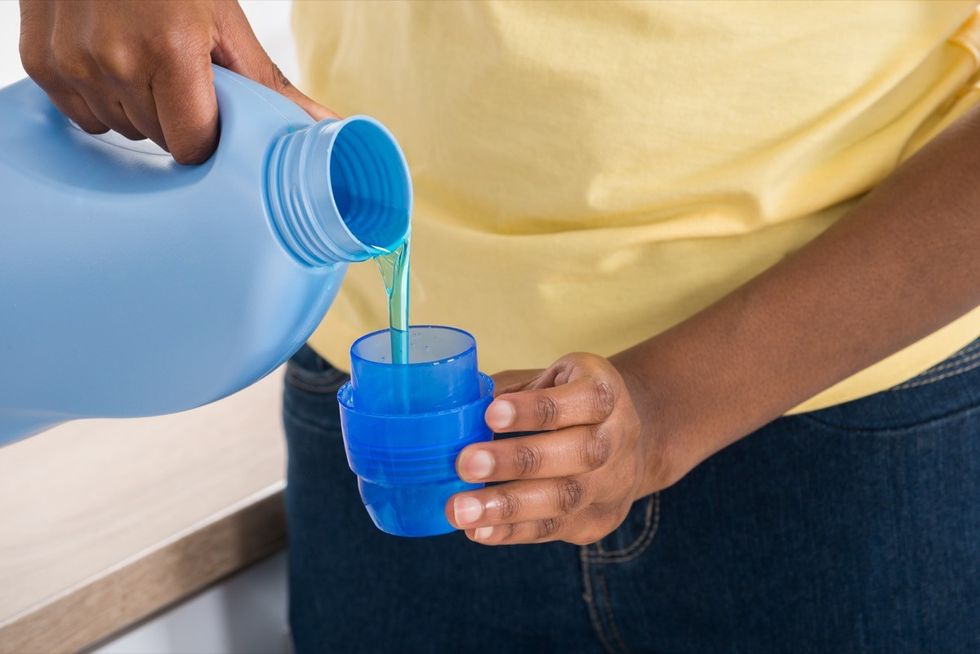Laundry is not exactly the most fun household chore, so it’s easy to go into autopilot and not pay attention to how clothing and towels are being washed and dried. Small mistakes can cause the disintegration of even the most hardy of fabrics, costing you time and money over the long run. If your laundry routine is not cutting it, you might be making some very common errors. Here are 8 laundry mistakes that are shortening your clothes’ lifespan, according to experts.
RELATED: This Clever Hack Will Keep Your Laundry Smelling Fresh.
1. Using Detergent Incorrectly
Shutterstock
Always read the instructions on your laundry detergent to make sure you are using it correctly. “We know that many consumers do not put Tide PODs into their machine correctly (whether they use them in a dispenser that isn’t designed for liquid laundry packets or put them in after the clothes),” Jennifer Ahoni, P&G fabric care principal scientist tells Homes & Gardens. “For the best results, put your Tide PODS liquid laundry pac directly into the drum, before loading your clothes.”
2. Open Zippers and Closed Buttons
Shutterstock
Leaving zippers undone and buttons closed will prevent proper cleaning. “Open zippers have teeth that can abrade fabrics as they circulate together in a clothes washer, especially metal zippers,” Mary Gagliardi, Clorox’s in-house scientist and cleaning expert, tells Martha Stewart. “Zipping them closed prior to washing protects both the item and the rest of the laundry. The insides of collars on dress shirts could benefit from a little more mechanical action in the clothes washer to help remove soil that accumulates there. Same goes for the cuffs, too.”
3. Overloading the Machine

Putting too much in can prevent your machine from doing what it needs to. “Overloading a washer can make it difficult for a washer to work well because the clothes can’t circulate, tumble, or bounce through the wash solution freely so they won’t get as clean,” Gagliardi says. “An overloaded washer may have difficulty balancing the load, which is necessary to achieve high spin speeds to adequately extract wash and rinse water from load.”
4. Fabric Softener Is Not a Detergent!
Shutterstock
Do not use fabric softener as a way to clean your clothes. “We also see a surprising number of consumers who think fabric softener is detergent,” Ahoni says. “Fabric softener does not have any soil-removing properties; when used correctly, it is released during the rinse cycle of your washing machine to deposit technology that lubricates fibers, softening them and helping to protect them from damage.”
5. Ignoring Care Labels

Care labels on clothes are there for a reason—make sure to pay attention to them. “You should always check and follow care labels for the best guidance to wash and dry,” Ahoni says. “Not following care label instructions or mistaking them for something else can result in damage such as shrinking, loss of shape, or fading – there is a reason they are there, after all.”
6. Ignoring Dryer Maintenance

Your dryer needs TLC, too. “Your lint trap should be cleaned after every cycle and your dryer vent should be cleaned at least once every two years,” Sarah Armstrong, new product brand manager for Maytag, tells Martha Stewart. “You can also deep clean your lint trap every six months or when you start noticing lint build-up.”
7. Leaving Wet Clothes In the Wash
Set a timer so you don’t leave clothes sitting in the washing machine. “One of the most common mistakes I see is forgetting the wash in the washer,” Christen Jeziorski, homecare expert, tells Homes & Gardens. “This is so easy to do but can be costly in a variety of ways. Washing machines, especially the front loading types, tend to create a musty smell in damp fabric that sits too long. This results in typically washing the item again which costs you time, detergent, water, and electricity. Not to mention unnecessary damage to clothing because the fibers of the fabric break down a little every time you wash them. Taking your laundry out right away is the best laundry hack to save time in the long run.”
8. Not Sorting By Color and Fabric
Shutterstock
It’s tempting to just throw everything in the wash, but this is not good for your clothes. “Yes, this can mean washing more loads of laundry, but if you make the mistake of not sorting and just throwing everything in together, you can end up with problems like dye transfer or lint buildup,” Gagliardi says. “Dye transfer can be immediately visible or it contributes to the dingy appearance of light-colored laundry after several wash cycles. Lint buildup happens when fabrics that attract lint (like corduroy) end up covered in fiber pills produced from items like towels that readily produce lint.”
RELATED: Why Experts Say You Should Rethink Using Fabric Softener.





